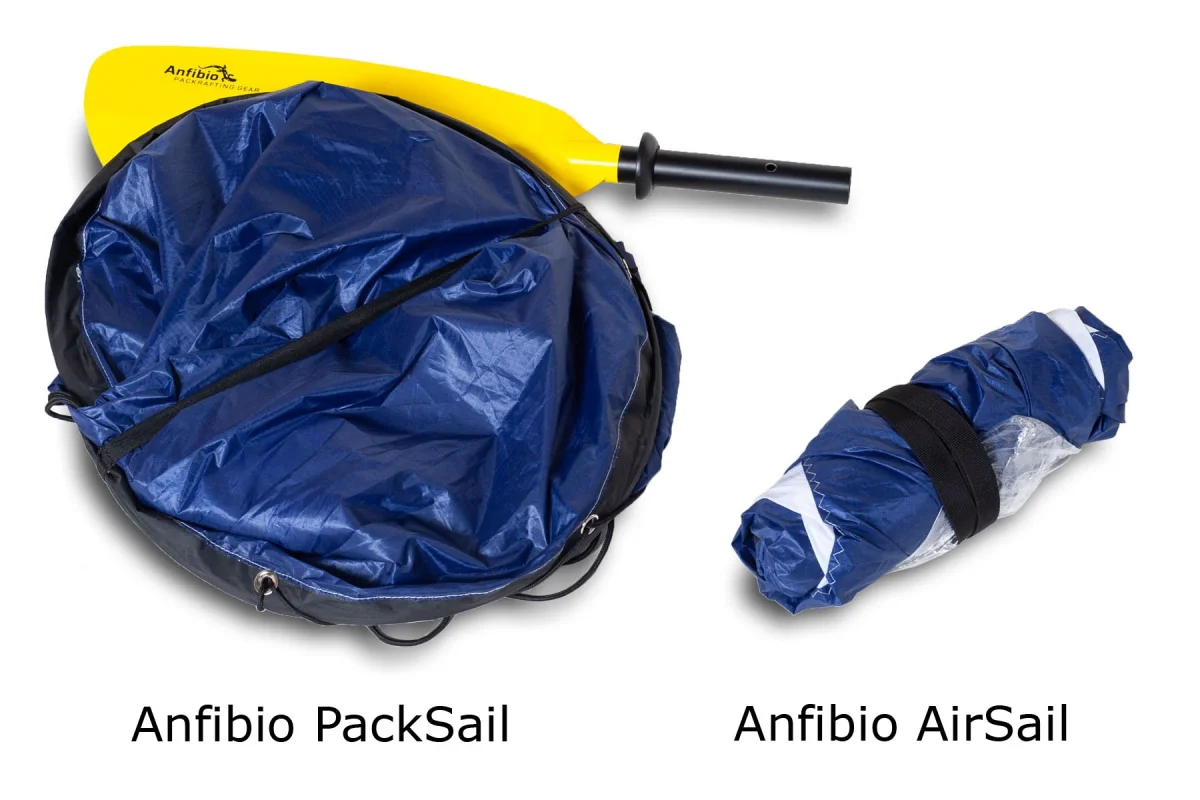Packsailing - this is the new way of applying your packraft. The sails take the possibilities of packrafting to a new level. Imagine to travel with the wind on a pocket size sail. It is easy to plan new types of trips with that. The sail utilizes the wind power as an effective way of propulsion. That means you are not just dragged down the wind, but you can max out to a fair 50 degree of side wind. So you will actually follow an angle, not just back/tail wind. Packrafts will capture bigger lakes and bays by that. Speed is no longer bound to run along moving water.
Application
Uncoil the batten and connect clips on the mounting harness to the front grap loops of your packraft or directly your backpack attached. A continuous sheet (or steering line) allows the paddler to easily control the sail while keeping the paddle in their hands for steering and stay on course. To reduce the windward drift, we recommend using one or more fins / skegs on the packraft (e.g. Anfibio Skeg).
Use
- Crossing of open waters as an integral part of a tour (taking into account the wind direction)
- Special "sailing tours" which are adapted according to the wind direction, so that either the outward, or the return way is covered on land.
Construction
The batten makes a stiff ring that can be folded in a tripple loop. Seams are welded and zig-zag sewn, sail makers construction method proven over the years. There is also a large window in the center panel of the sail for vision, made from clear TPU. The design puts the center of force of the sail down low, at about the same level as the paddler, making the boat/sail combination incredibly stable and easy-to-use. The sail fits all Packrafts.
Anfibio PackSail vs. Anfibio AirSail
The main difference between the two sails lies in the construction of the frame. The resulting difference in pack size can be seen in the graphic below. The difference in weight is only 12g. In addition, it should be noted that a pump (e.g. Anfibio HandPump) must be carried for the AirSail, which increases the pack size accordingly. Due to its diverse functions, a hand pump is also ideal for inflating and re-inflating a packraft and is therefore a useful addition to paddle luggage regardless of a sail. The Anfibio AirSail is also very quick to pack up (deflate and roll up), which means that the sail can be taken down directly on the water without any fuss. The Anfibio PackSail, on the other hand, shows its strength in setting up in seconds, but is more difficult to take down (folding).

Experience
“A loaded packraft starts moving already in around 2 m/s, quickly reaching a normal paddling speed of 3-4 km/h, but things get interesting once the wind speed exceeds 6 m/s and you start moving faster and get a lot more power, allowing maneuvers and tricks, like jibes and slalom turns, and get to surf on the bigger waves with the help of the sail (a great feeling!). Agile and nimble, you can play close to each other, bump to each other, use the other's backwash for tricks, and so on. Unlimited fun!“ Joni P./valppaaus.com
See review and video tab for further inspiration!
Pictures courtesy of Marko E. Takanen (Twitter @mtakanen)
Information according General Product Safety Regulation
Manufacturer: Anfibio Packrafting, Schellin & Kreinacker GbR, Körnerplatz 6, 04107 Leipzig , Germany,
info@anfibio.com
Material: Nylon, large transparent window made of robust TPU, polypropylene rope, hooks and connectors made of molleton, rigid and stable frame that can still be easily rolled up and folded together.
Diameter: 130cm
Pack size: 41x47cm
Weigth: 478g
Packsailing by Joeryby Joery!
"I have managed to sail the entire Belgian coastline in one single day. Sailing the entire 67km in a packraft? It’s done before you realize it!"
All reviews: